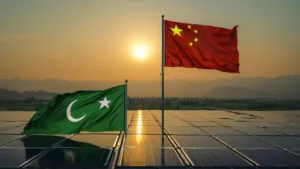Pakistan has rapidly emerged as a crucial market for Chinese photovoltaic (PV) companies, marking a significant milestone in its energy transformation journey. According to the latest statistics from the China Photovoltaic Industry Association (CPIA), Asia has overtaken Europe as the largest export destination for PV products, with Pakistan now standing as the second-largest market for module exports, trailing only Europe.
In the first half of 2024, China exported inverters to Pakistan valued at RMB 1.714 billion. Notably, the exports surged in August, reaching 326 million yuan—an impressive year-on-year increase of 429.04%. This growth is evident as shimmering blue panels adorn the rooftops of factories, households, hospitals, and mosques across the nation.
The dramatic rise in photovoltaic and related product exports highlights Pakistan’s urgent shift toward renewable energy generation. “Electricity prices continue to rise; thus, people are trying to find their way out,” stated Abbas, a Pakistani trader, during the Investment and Trade Forum for Cooperation between East and West China.

As of June 2023, Pakistan’s installed solar power capacity was only 630 megawatts, representing just 1.4% of the total installed power capacity—indicating vast potential for expansion. The World Bank’s Global Solar Atlas data shows that regions like Balochistan, with favorable sunlight conditions, can yield an average annual photovoltaic output of 1990 kWh from a 1 kW household solar system. This output is approximately 41% and 59% higher than New Delhi, India, and Shandong Province, China, respectively.
In recent years, the Pakistani government has demonstrated strong support for renewable energy development, setting ambitious targets to increase the share of renewable and alternative energy in the electricity market to 20% by 2025 and 30% by 2030. The Integrated Generation Capacity Expansion Plan (IGCEP) 2047, released by NEPRA, projects significant growth in PV capacity, anticipating a leap to 12.8 GW by 2030 and 26.9 GW by 2047. To meet these targets, an average annual new PV installed capacity of 1.65 GW by 2030 and 1.07 GW by 2047 is necessary.
As businesses in Pakistan rush to equip their factory rooftops with affordable Chinese solar panels, the momentum continues to build. “Every bit of space I have, even if it’s a few feet, I want it covered in solar panels,” said Khawaja Masood Akhtar, CEO of Forward Sports, a leading manufacturer of footballs. Over the past two years, his company has doubled its solar energy use, raising its share to 50%. Akhtar is now reinvesting a portion of last year’s profits into importing additional panels from China, aiming to increase solar energy’s contribution to his operations to 80%.
As Pakistan forges ahead in its solar energy journey, the collaboration with Chinese PV companies represents a promising future for renewable energy in the region, positioning Pakistan as a key player in the global solar market.
